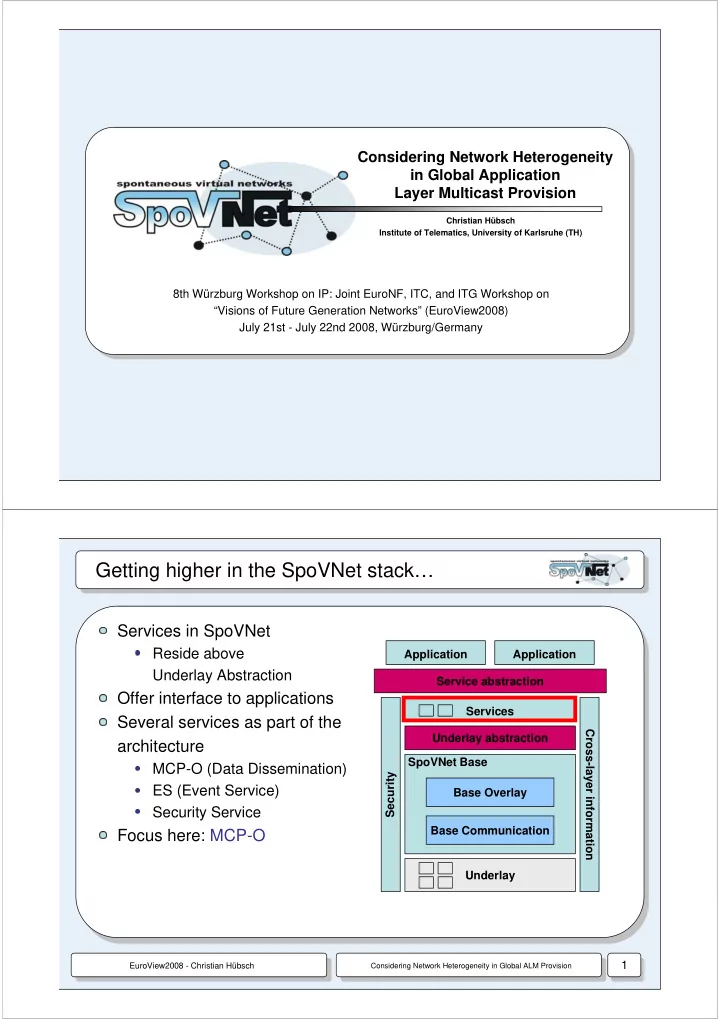

Considering Network Heterogeneity in Global Application Layer Multicast Provision Christian Hübsch Institute of Telematics, University of Karlsruhe (TH) 8th Würzburg Workshop on IP: Joint EuroNF, ITC, and ITG Workshop on “Visions of Future Generation Networks” (EuroView2008) July 21st - July 22nd 2008, Würzburg/Germany Getting higher in the SpoVNet stack… Services in SpoVNet Reside above Application Application Underlay Abstraction Service abstraction Offer interface to applications Services Several services as part of the Cross-layer information Underlay abstraction architecture SpoVNet Base MCP-O (Data Dissemination) Security ES (Event Service) Base Overlay Security Service Base Communication Focus here: MCP-O Underlay 1 EuroView2008 - Christian Hübsch Considering Network Heterogeneity in Global ALM Provision
Goal: Efficient Data Dissemination Group Communication in SpoVNet instances Router End System Solution: Application Layer Multicast (ALM) Overlay Link Underlay Link Several existing approaches Narada, NICE, Yoid, Nemo, … Each with different target applications Drawbacks Considering homogeneous (UDP-)underlays Measure link property themselves • Mostly latency SpoVNet Vision Global service provision • Heterogeneity of nodes and network! Different application demands 2 EuroView2008 - Christian Hübsch Considering Network Heterogeneity in Global ALM Provision NICE Achieve scalability through hierarchical clustering Limit protocol overhead Consider node distances (n-2-n latencies) Logical structure determines date dissemination Cluster Leader Cluster Member Cluster 3 EuroView2008 - Christian Hübsch Considering Network Heterogeneity in Global ALM Provision
MCP-O Protocol Design Basic idea (enhance NICE approach to…) Evaluate application demands for structural design decisions Consider Cross-Layer-Information (provided by CLIO comp.) Built efficient dissemination topologies for every use case Use underlay functionality where possible Structure Application QoS Info Request (QoS) Requirements N-2-n-Links Base CLIO MCP-O Link QoS Info Request 4 EuroView2008 - Christian Hübsch Considering Network Heterogeneity in Global ALM Provision Service Demands Adaption Use Service Metric to affect building of structure Weights a i determined through application requirements f i (x,y) e.g. latency, same WiFi domain, same IP Multicast domain, … Cluster Leader Cluster Member Cluster IP Multicast Broadcast Domain Domain 5 EuroView2008 - Christian Hübsch Considering Network Heterogeneity in Global ALM Provision
Service Demands Adaption But: Hierarchical approach not always the best choice Good scalability, but cutting back e.g. latencies � Example: Latency-sensitive app with < 16 Members Adapt cluster size K K = (lowest current upstream) / (data stream) Unicast brings best achievable latency, protocol decides reasonable overhead in bounds 6 EuroView2008 - Christian Hübsch Considering Network Heterogeneity in Global ALM Provision Examples for Protocol Behavior Single Source Videostreaming application Locate High-Bandwidth nodes near source Make them cluster leader, upstream determines cluster size � Flat tree to bound latency and jitter Realtime Game Latency critical factor Use unicast where feasible 7 EuroView2008 - Christian Hübsch Considering Network Heterogeneity in Global ALM Provision
WiFi Integration First Steps: Wireless Integration Save transmission overhead through broadcast � NICE-WLI Introduce Gateway-Nodes for mediation WiFi domain not part of structure, but connected through Gateway Prevent Gateways from becoming cluster leaders (save overhead) AP 8 EuroView2008 - Christian Hübsch Considering Network Heterogeneity in Global ALM Provision WiFi Integration Approach saves data transmission overhead Figure: P(WLAN) denotes probability of WiFi node Traffic per node Node count 9 EuroView2008 - Christian Hübsch Considering Network Heterogeneity in Global ALM Provision
Summary & Outlook Efficient data transmission for SpoVNet applications through Considering node and network heterogeneity Use appropriate dissemination strategies • IP Multicast, broadcast, QoS reservations,… WiFi support already integrated Further Work Multiple group support per instance Usage of underlay features 10 EuroView2008 - Christian Hübsch Considering Network Heterogeneity in Global ALM Provision
Recommend
More recommend